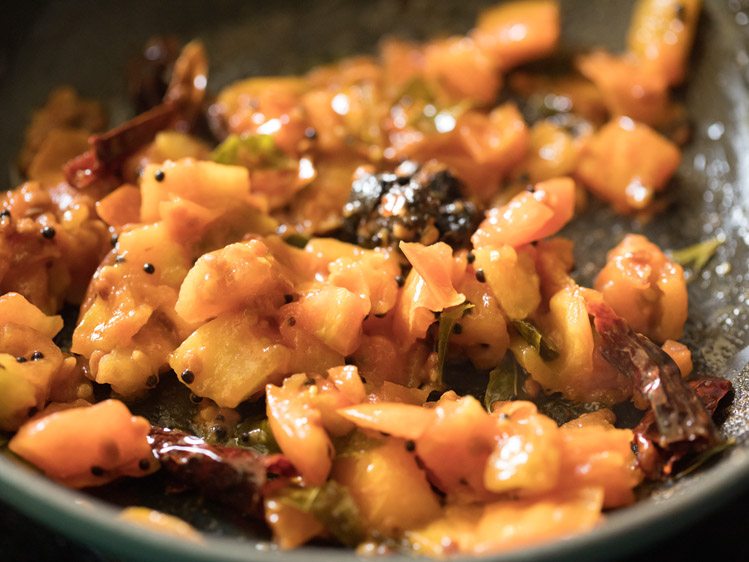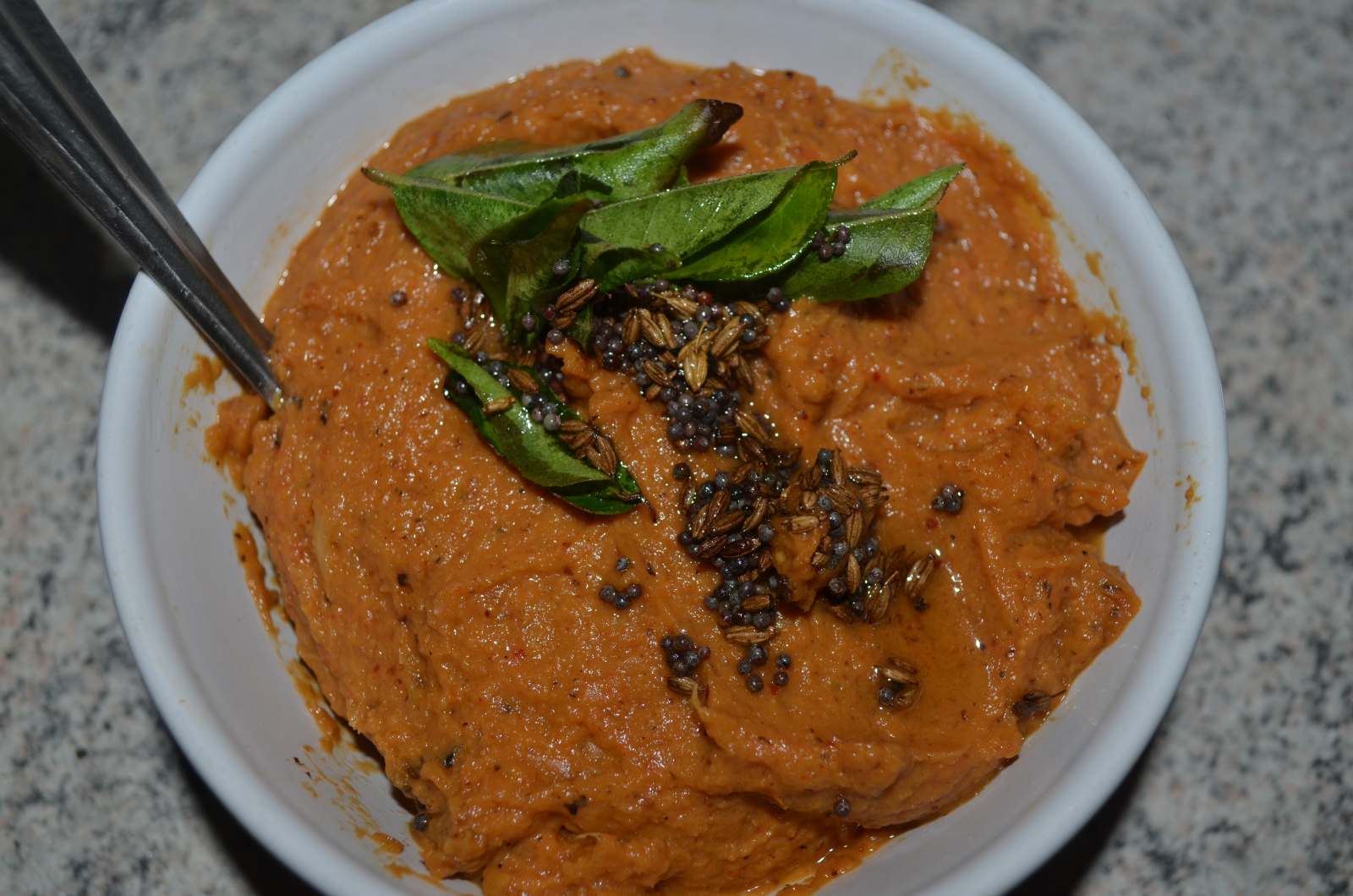Embark on a culinary adventure as we delve into the delectable world of Tomato Pachadi, a vibrant condiment that holds a cherished place in Indian cuisine. Its tantalizing blend of flavors and versatility makes it a beloved accompaniment to an array of dishes, adding a burst of tangy zest to every bite.
Let us explore the origins, variations, and culinary significance of this beloved condiment.
From its humble beginnings in the kitchens of South India, Tomato Pachadi has evolved into a staple across the country. Its vibrant red hue, derived from ripe tomatoes, symbolizes prosperity and joy, making it an indispensable part of festive celebrations and family gatherings.
The harmonious balance of sweet, sour, and spicy notes in Tomato Pachadi makes it a culinary masterpiece that tantalizes the taste buds.
Introduction to Tomato Pachadi Recipe
Tomato Pachadi is a traditional South Indian dish that holds a significant place in the culinary repertoire of the region. Originating in the state of Tamil Nadu, it is a versatile accompaniment that can be paired with a variety of dishes, including rice, idlis, and dosas.
The ingredients used in Tomato Pachadi are not only flavorful but also packed with nutritional value. Tomatoes, the primary ingredient, are a rich source of vitamins A, C, and K, as well as lycopene, an antioxidant that has been linked to numerous health benefits.
Nutritional Value of Ingredients
- Tomatoes: Rich in vitamins A, C, and K, as well as lycopene.
- Tamarind: Contains dietary fiber, potassium, and vitamin C.
- Mustard seeds: A good source of protein, omega-3 fatty acids, and antioxidants.
- Curry leaves: Rich in antioxidants and have anti-inflammatory properties.
Variations of Tomato Pachadi Recipe
Tomato Pachadi, a versatile dish, boasts regional variations that add a unique twist to its flavor profile. These variations showcase the diverse culinary traditions and preferences across India.
Regional Variations
- Tamil Nadu: In Tamil Nadu, the pachadi is typically made with roasted tomatoes, lending a smoky flavor. Green chilies and curry leaves add a spicy kick, while tamarind provides tanginess.
- Andhra Pradesh: Andhra Pradesh’s version features sautéed tomatoes, with the addition of urad dal (black lentils) and peanuts. The pachadi is seasoned with mustard seeds, cumin, and red chilies, resulting in a nutty and aromatic flavor.
- Kerala: Kerala’s Tomato Pachadi incorporates grated coconut, which adds a creamy texture and a subtle sweetness. The use of coconut oil adds a distinctive aroma, while the inclusion of fenugreek seeds and asafoetida lends a unique flavor.
Step-by-Step Tomato Pachadi Recipe
Preparing Tomato Pachadi is a straightforward process that involves a few simple steps. Gather your ingredients and follow the instructions carefully to create a flavorful and tangy side dish that complements any meal.
Ingredients:
- 2 medium-sized tomatoes, finely chopped (about 2 cups)
- 1/2 cup grated coconut
- 1/4 cup roasted peanuts
- 1 teaspoon mustard seeds
- 1 teaspoon cumin seeds
- 1 green chili, finely chopped (optional)
- 1/4 teaspoon turmeric powder
- 1/4 teaspoon red chili powder
- 1 tablespoon tamarind paste
- 1 tablespoon jaggery or brown sugar (optional)
- 1/2 teaspoon salt, or to taste
- 2 tablespoons coconut oil
- Fresh coriander leaves for garnish
Instructions:
1. Prepare the Base
In a large pan or skillet, heat the coconut oil over medium heat. Add the mustard seeds and cumin seeds. Once they start to splutter, add the finely chopped tomatoes and green chili (if using). Cook until the tomatoes soften and release their juices.
2. Add Spices and Coconut
Add the turmeric powder, red chili powder, tamarind paste, and jaggery (if using) to the pan. Stir well to combine and cook for a few minutes, until the spices are fragrant and the tomatoes are fully cooked. Stir in the grated coconut and roasted peanuts.
3. Simmer and Season
Bring the mixture to a simmer and cook for 10-15 minutes, or until the pachadi thickens slightly. Season with salt to taste.
4. Garnish and Serve
Remove the pachadi from heat and garnish with fresh coriander leaves. Serve as a side dish with rice, dal, or any other Indian dish.
Enjoy the tangy and flavorful Tomato Pachadi, a versatile side dish that adds a touch of spice and acidity to your meals.
Tips and Techniques for Making Tomato Pachadi

Crafting a flavorful and well-balanced tomato pachadi requires attention to detail and a few clever techniques. Here’s a comprehensive guide to help you achieve the perfect pachadi every time.
Selecting the Best Tomatoes
The quality of tomatoes plays a pivotal role in the taste of your pachadi. Opt for ripe, juicy tomatoes with vibrant red color and firm texture. Avoid tomatoes that are bruised, soft, or have green patches.
Enhancing Tomato Flavor
To elevate the flavor of your tomatoes, try roasting them before adding them to the pachadi. Roasting caramelizes the sugars in the tomatoes, intensifying their sweetness and creating a rich, smoky undertone.
Achieving the Desired Consistency
The consistency of your pachadi is crucial for a satisfying eating experience. For a thick, gravy-like pachadi, cook it for an extended period until the tomatoes break down and release their juices. If you prefer a thinner consistency, add a little water or coconut milk while cooking.
Textural Perfection
For a smooth and creamy pachadi, blend the cooked tomatoes until they reach your desired consistency. If you enjoy a bit of texture, you can leave some small chunks of tomatoes in the pachadi.
Serving Suggestions for Tomato Pachadi
Tomato Pachadi’s versatility extends beyond its primary use as a side dish. Its tangy and flavorful profile makes it an excellent accompaniment to a variety of dishes.
As a Side Dish
- Serve alongside grilled meats, such as chicken, fish, or lamb, to balance the richness of the protein.
- Pair with rice or flatbreads, like roti or naan, to create a satisfying meal.
- Use as a dipping sauce for vegetable crudités or crackers for a refreshing and flavorful snack.
In Salads
- Add a spoonful to leafy green salads for a burst of flavor and acidity.
- Combine with chopped vegetables, such as cucumbers, onions, and peppers, to create a vibrant and tangy salad.
In Sandwiches
- Spread a layer of Tomato Pachadi on bread or tortillas as a flavorful condiment.
- Add to grilled cheese sandwiches for a tangy twist.
Health Benefits of Tomato Pachadi

Tomato Pachadi is not only a delicious condiment but also a nutritional powerhouse. It is packed with antioxidants, vitamins, and minerals that contribute to overall health and well-being.
Tomatoes, the main ingredient in Tomato Pachadi, are a rich source of lycopene, a powerful antioxidant that has been linked to a reduced risk of chronic diseases such as heart disease and cancer. Lycopene is also known for its anti-inflammatory properties, which can help protect against conditions like arthritis and asthma.
Antioxidant Properties
- Tomato Pachadi is a rich source of antioxidants, primarily lycopene, which helps protect cells from damage caused by free radicals.
- Antioxidants play a crucial role in reducing the risk of chronic diseases such as heart disease, cancer, and neurodegenerative disorders.
Anti-inflammatory Properties
- Lycopene and other antioxidants in Tomato Pachadi possess anti-inflammatory properties.
- Anti-inflammatory compounds help reduce inflammation throughout the body, which can alleviate symptoms of conditions like arthritis, asthma, and inflammatory bowel disease.
Vitamins and Minerals
- Tomato Pachadi is a good source of vitamins A, C, and K, as well as minerals like potassium and manganese.
- These nutrients are essential for maintaining healthy bones, skin, eyes, and immune function.
Cultural Significance of Tomato Pachadi
Tomato Pachadi holds a special place in Indian culture, symbolizing familial bonds, festive celebrations, and regional culinary traditions. Its versatility extends beyond its culinary appeal, deeply entwined with the fabric of Indian society.
During festivals like Diwali and Onam, Tomato Pachadi is a staple dish, gracing dining tables and adding a vibrant touch to the festive atmosphere. It is often prepared in large batches and shared with family and friends, fostering a sense of togetherness and community.
In Regional Traditions
Tomato Pachadi also plays a significant role in regional cuisines across India. In Andhra Pradesh, it is known as Tamata Pachadi and is a popular accompaniment to rice dishes. In Tamil Nadu, it is called Thakkali Pachadi and is often served with idli or dosa.
In Karnataka, Tomato Pachadi is known as Tomato Saar and is a staple in many households. Its tangy and spicy flavor complements both traditional and modern dishes, making it a beloved culinary creation.
Last Point
As we conclude our exploration of Tomato Pachadi, let us remember its versatility and the joy it brings to our culinary creations. Whether savored as a condiment, an ingredient in salads, or a flavorful dipping sauce, Tomato Pachadi adds a touch of magic to every dish.
Its nutritional benefits, coupled with its cultural significance, make it a true gem in the culinary landscape of India. So, let us embrace the vibrant flavors of Tomato Pachadi and continue to relish its culinary wonders for generations to come.
FAQ
What is the origin of Tomato Pachadi?
Tomato Pachadi originated in the kitchens of South India, where it has been a beloved condiment for centuries.
What are the key ingredients in Tomato Pachadi?
The key ingredients in Tomato Pachadi include ripe tomatoes, tamarind, jaggery, chili peppers, and spices like mustard seeds and fenugreek.
What are the health benefits of Tomato Pachadi?
Tomato Pachadi is rich in antioxidants and anti-inflammatory compounds, making it a healthy addition to your diet.
How can I store Tomato Pachadi?
Tomato Pachadi can be stored in an airtight container in the refrigerator for up to 3-4 days.
Can I make Tomato Pachadi without tamarind?
Yes, you can substitute lemon juice or vinegar for tamarind in Tomato Pachadi.
